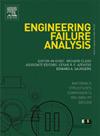扩散焊TC4钛合金室温和高温拉伸疲劳断裂行为
IF 5.7
2区 工程技术
Q1 ENGINEERING, MECHANICAL
引用次数: 0
摘要
研究了基体组织和结合界面特征对扩散结合(DB) TC4钛合金室温和400℃拉伸疲劳性能的协同作用。由于风机叶片的精密制造要求,对DB接头进行了不同冷却条件(750 ~ 850℃)的双阶段热处理。在室温下,基体组织的演变导致DB接头的抗拉强度和疲劳寿命明显下降。在400℃时,所有拉伸试样都表现出韧性断裂形态,抗拉强度与界面或基体微观组织演化的关系可以忽略不计。而基体组织和DB界面对400℃疲劳性能的影响与载荷条件密切相关。在400℃、315 MPa(50%抗拉强度)的疲劳试验中,体积分数为10.5%的花瓣状α + β菌落抑制了DB接头的裂纹扩展。相反,滑移方向与疲劳加载方向平行的优先取向β晶粒,以及体积分数为21.5%的板条α + β菌落有利于裂纹的萌生和扩展。值得注意的是,当疲劳裂纹扩展到DB界面的弱结合区时,裂纹扩展受到阻碍,并伴有裂纹尖端塑性区收缩。在较高的疲劳载荷(拉伸强度的70%)下,无论测试温度(室温或400℃)如何,裂纹扩展都在DB界面的微孔处加速。断口表面的塑性应变最小,导致两种具有明显α + β集落组织的热处理DB接头的疲劳寿命差异可以忽略不计。本文章由计算机程序翻译,如有差异,请以英文原文为准。

Fracture behavior in tensile and fatigue tests of diffusion bonded TC4 titanium alloy at room and high temperatures
The synergistic effects of matrix microstructure and bonding interface characteristics on the tensile and fatigue properties of the diffusion bonded (DB) TC4 titanium alloy at room temperature and 400℃ were studied. A double-stage heat treatment with various cooling conditions (750-850℃) was performed on the DB joints due to the precision manufacturing requirements of the fan blade. Matrix microstructure evolution caused significant tensile strength and fatigue life degradation of the DB joint at room temperature. At 400 °C, all tensile specimens exhibited ductile fracture morphology, with tensile strength showing negligible dependence on interface or matrix microstructure evolution. However, the influence of matrix microstructure and DB interface on fatigue performance at 400℃ was strongly related to the load conditions. During fatigue testing at 400℃ and 315 MPa (50 % of the tensile strength), the petal-like α + β colonies with a volume fraction of 10.5 % inhibited the crack propagation of the DB joint. Conversely, the preferentially oriented β grains with the < 111 > slip direction aligned parallel to the fatigue loading direction, along with lath α + β colonies exhibiting a 21.5 % volume fraction, facilitated crack initiation and propagation. Notably, when fatigue cracks extended into the weakly bonded region at the DB interface, crack propagation was impeded, accompanied by a shrinkage of the plastic zone at the crack tip. Under higher fatigue loads (70 % of the tensile strength), crack propagation was accelerated at the micro-pores of the DB interface, irrespective of testing temperature (room temperature or 400 °C). The fracture surfaces exhibited minimal plastic strain, resulting in negligible differences in fatigue life between the two heat-treated DB joints with distinct α + β colony microstructures.
求助全文
通过发布文献求助,成功后即可免费获取论文全文。
去求助
来源期刊

Engineering Failure Analysis
工程技术-材料科学:表征与测试
CiteScore
7.70
自引率
20.00%
发文量
956
审稿时长
47 days
期刊介绍:
Engineering Failure Analysis publishes research papers describing the analysis of engineering failures and related studies.
Papers relating to the structure, properties and behaviour of engineering materials are encouraged, particularly those which also involve the detailed application of materials parameters to problems in engineering structures, components and design. In addition to the area of materials engineering, the interacting fields of mechanical, manufacturing, aeronautical, civil, chemical, corrosion and design engineering are considered relevant. Activity should be directed at analysing engineering failures and carrying out research to help reduce the incidences of failures and to extend the operating horizons of engineering materials.
Emphasis is placed on the mechanical properties of materials and their behaviour when influenced by structure, process and environment. Metallic, polymeric, ceramic and natural materials are all included and the application of these materials to real engineering situations should be emphasised. The use of a case-study based approach is also encouraged.
Engineering Failure Analysis provides essential reference material and critical feedback into the design process thereby contributing to the prevention of engineering failures in the future. All submissions will be subject to peer review from leading experts in the field.
 求助内容:
求助内容: 应助结果提醒方式:
应助结果提醒方式:


